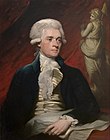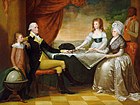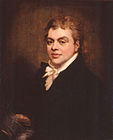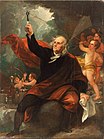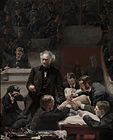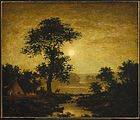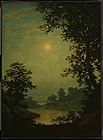Visual art of the United States
| This article is part of a series on the |
| Culture of the United States |
|---|
 |
| Society |
| Arts and literature |
| Other |
| Symbols |
|
United States portal |

Visual art of the United States or American art is
But in the later 18th century two U.S. artists,
After 1850 Academic art in the European style flourished, and as richer Americans became very wealthy, the flow of European art, new and old, to the US began; this has continued ever since. Museums began to be opened to display much of this. Developments in modern art in Europe came to the U.S. from exhibitions in New York City such as the Armory Show in 1913. After World War II, New York replaced Paris as the center of the art world. Since then many U.S. movements have shaped Modern and Postmodern art. Art in the United States today covers a huge range of styles.
Beginnings
One of the first painters to visit British America was
Among the earliest was
Eighteenth century
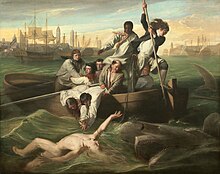
After the
Robert Feke (1707–1752), an untrained painter of the colonial period, achieved a sophisticated style based on Smibert's example.[3] Charles Willson Peale, who gained much of his earliest art training by studying Smibert's copies of European paintings,[4] painted portraits of many of the important figures of the American Revolution. Peale's younger brother James Peale and six of Peale's nieces and sons— Anna Claypoole Peale, Sarah Miriam Peale, Raphaelle Peale, Rembrandt Peale, Rubens Peale and Titian Peale—were also artists. Painters such as Gilbert Stuart made portraits of the newly elected government officials,[1] which became iconic after being reproduced on various U.S. Postage stamps of the 19th century and early 20th century.[5]
Selection of works by early American artists
-
Jeremiah Theus Portrait of Lady Liberty, 1765
-
The Treaty of Penn with the Indians, 1771–72, Pennsylvania Academy of the Fine Arts in Philadelphia
-
Museum of Fine Arts Houston
-
Ralph Earl, Portrait of Oliver Ellsworth and Abigail Wolcott Ellsworth, 1792, Wadsworth Atheneum
-
James Peale, The Artist and His Family, 1795. Pennsylvania Academy of the Fine Arts
-
John Brewster Jr., Mother with Son (Lucy Knapp Mygatt and Son, George, of Danbury, Connecticut), 1799
-
Washington Allston, Moonlit Landscape, 1809, Museum of Fine Arts, Boston, Massachusetts
Nineteenth century

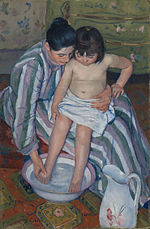
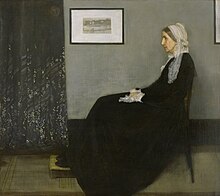
The first well-known U.S. school of painting—the Hudson River School—appeared in 1820. Thomas Cole pioneered the movement which included Albert Bierstadt, Frederic Edwin Church, Thomas Doughty and several others. As with music and literature, this development was delayed until artists perceived that the New World offered subjects unique to itself; in this case the westward expansion of settlement brought the transcendent beauty of frontier landscapes to painters' attention.
The Hudson River painters' directness and simplicity of vision influenced and inspired such later artists as
The Hudson River School landscape painter
Paintings of the Great West, many of which emphasized the sheer size of the land and the cultures of the native people living on it, became a distinct genre as well.
Portrait painters in the U.S. in the 19th century included untrained limners such as Ammi Phillips, and painters schooled in the European tradition, such as Thomas Sully and G.P.A. Healy. Middle-class city life found its painter in Thomas Eakins (1844–1916), an uncompromising realist whose unflinching honesty undercut the genteel preference for romantic sentimentalism. As a result, he was not notably successful in his lifetime, although he has since been recognized as one of the most significant U.S. artists.[11] One of his students was Henry Ossawa Tanner, the first African-American painter to achieve international acclaim.
A
The most successful U.S. sculptor of his era, Hiram Powers, left the U.S. in his early thirties to spend the rest of his life in Europe, where he adopted a conventional style for his idealized female nudes such as Eve Tempted.[12] Several important painters who are considered American spent much of their lives in Europe, notably Mary Cassatt, James McNeill Whistler, and John Singer Sargent, all of whom were influenced by French Impressionism. Theodore Robinson visited France in 1887, befriended Monet, and became one of the first U.S. painters to adopt the new technique. In the last decades of the century American Impressionism, as practiced by artists such as Childe Hassam and Frank W. Benson, became a popular style.
Selection of notable 19th-century works

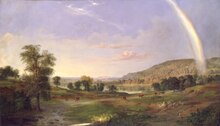
-
Edward Hicks, Peaceable Kingdom, c. 1834, National Gallery of Art
-
John J. Audubon, Washington Sea Eagle, c. 1836–1839, Smithsonian American Art Museum
-
George Catlin, An Indian Ball-Play c. 1846–1850, Smithsonian American Art Museum
-
George Caleb Bingham, Daniel Boone Escorting Settlers through the Cumberland Gap, 1851–52
-
Eastman Johnson, A Ride for Liberty – The Fugitive Slaves, oil on paperboard, ca. 1862, Brooklyn Museum
-
Phillips Collection
-
-
Nocturne: Blue and Gold - Old Battersea Bridge (1872), Tate Britain, London, England
-
Boston Museum of Fine Arts
-
Albert Pinkham Ryder, The Waste of Waters is Their Field, early 1880s, Brooklyn Museum
-
Ralph Albert Blakelock, Moonlight, 1885, Brooklyn Museum
-
Phillips Collection, Washington, D.C.
-
Ralph Albert Blakelock, Moonlight Sonata, 1889–1892, Museum of Fine Arts, Boston
-
The Metropolitan Museum of Art, New York City
-
Frederic Remington, Aiding a Comrade, 1890, Museum of Fine Arts, Houston
-
Charles M. Russell, The Buffalo Hunt, 1899, Amon Carter Museum of American Art
-
oil on canvas, Metropolitan Museum of Art, New York City
Twentieth century
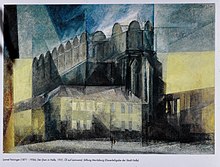

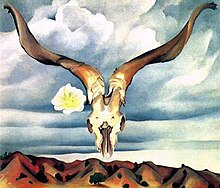
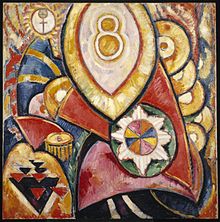
Controversy soon became a way of life for American artists. In fact, much of American painting and sculpture since 1900 has been a series of revolts against tradition. "To hell with the artistic values," announced
Soon the Ashcan school artists gave way to
After
The American Southwest
Following the
Images of the Southwest became a popular form of advertising, used most significantly by the Santa Fe Railroad to entice settlers to come west and enjoy the "unsullied landscapes." Walter Ufer, Bert Geer Phillips, E. Irving Couse, William Henry Jackson, Marsden Hartley, Andrew Dasburg, and Georgia O'Keeffe were some of the more prolific artists of the Southwest. Georgia O'Keeffe, who was born in the late 19th century, became known for her paintings featuring flowers, bones, and landscapes of New Mexico as seen in Ram's Head White Hollyhock and Little Hills. O'Keeffe visited the Southwest in 1929 and moved there permanently in 1949; she lived and painted there until she died in 1986.
Harlem Renaissance (1920s-1930s)
The
New Deal art (1930s)

When the
The style of much of the public art commissioned by the WPA was influenced by the work of
Not all of the artists who emerged in the years between the wars were Regionalists or Social Realists; Milton Avery's paintings, often nearly abstract, had a significant influence on several of the younger artists who would soon become known as Abstract Expressionists.[19] Joseph Cornell, inspired by Surrealism, created boxed assemblages incorporating found objects and collage.
Abstract expressionism
In the years after World War II, a group of New York artists formed the first American movement to exert major influence internationally: abstract expressionism.
This term, which had first been used in 1919 in Berlin, was used again in 1946 by
The first generation of abstract expressionists included
Though the numerous artists encompassed by this label had widely different styles, contemporary critics found several common points between them. Gorky, Pollock, de Kooning, Kline, Hofmann, Motherwell, Gottlieb, Rothko, Still, Guston, and others were an American painters associated with the abstract expressionist movement and in most cases Action painting (as seen in Kline's Painting Number 2, 1954); as part of the New York School in the 1940s and 1950s.
Many first generation abstract expressionists were influenced both by the
Color Field painting
The emphasis and intensification of color and large open expanses of surface were two of the principles applied to the movement called
Color field painting continued as a movement in the 1960s, as Morris Louis, Jules Olitski, Kenneth Noland, Gene Davis, Helen Frankenthaler, and others sought to make paintings which would eliminate superfluous rhetoric with repetition, stripes and large, flat areas of color.[23]
After abstract expressionism
During the 1950s abstract painting in America evolved into movements such as
Lyrical Abstraction along with the Fluxus movement and Postminimalism (a term first coined by Robert Pincus-Witten in the pages of Artforum in 1969)[25] sought to expand the boundaries of abstract painting and Minimalism by focusing on process, new materials and new ways of expression. Postminimalism often incorporating industrial materials, raw materials, fabrications, found objects, installation, serial repetition, and often with references to Dada and Surrealism is best exemplified in the sculptures of Eva Hesse.[25]
Lyrical Abstraction,
Lyrical Abstraction shares similarities with Color Field Painting and Abstract Expressionism, especially in the freewheeling usage of paint texture and surface. Direct drawing, calligraphic use of line, the effects of brushed, splattered, stained, squeegeed, poured, and splashed paint superficially resemble the effects seen in Abstract Expressionism and Color Field Painting. However the styles are markedly different.[27][28]
During the 1960s, 1970s and 1980s painters as powerful and influential as Adolph Gottlieb,
Other modern American movements
Members of the next artistic generation favored a different form of abstraction: works of mixed media. Among them were Robert Rauschenberg (1925–2008) and Jasper Johns (1930- ), who used photos, newsprint, and discarded objects in their compositions. Pop artists, such as Andy Warhol (1928–1987), Larry Rivers (1923–2002), and Roy Lichtenstein (1923–1997), reproduced, with satiric care, everyday objects and images of American popular culture—Coca-Cola bottles, soup cans, comic strips.
Realism has also been continually popular in the United States, despite modernism's impact; the realist tendency is evident in the city scenes of Edward Hopper, the rural imagery of Andrew Wyeth, and the illustrations of Norman Rockwell. In certain places Abstract Expressionism never caught on; for example, in Chicago, the dominant art style was grotesque, symbolic realism, as exemplified by the Chicago Imagists Cosmo Campoli (1923–1997), Jim Nutt (1938- ), Ed Paschke (1939–2004), and Nancy Spero (1926–2009).
Contemporary art into the 21st century

At the beginning of the 21st century, contemporary art in the United States in general continues in several contiguous modes, characterized by the idea of Cultural pluralism. The "crisis" in painting and current art and current art criticism today is brought about by pluralism. There is no consensus, nor need there be, as to a representative style of the age. There is an anything goes attitude that prevails; an "everything going on" syndrome; with no firm and clear direction and yet with every lane on the artistic superhighway filled to capacity. Consequently, magnificent and important works of art continue to be made in the United States albeit in a wide variety of styles and aesthetic temperaments, the marketplace being left to judge merit.
, are a few continuing and current directions in painting at the beginning of the 21st century.Notable figures
A few
See also
- Aesthetics
- Architecture of United States
- Art education in the United States
- Cinema of the United States
- History of painting
- Ledger art
- Modern art museums in the United States
- Museums of American art
- National Museum of the American Indian
- Native American museums in New York
- Photography in the United States of America
- Sculpture of the United States
- Synchromism
- Timeline of Native American art history
- Timeline of 20th century printmaking in America
- Visual arts of Chicago
- Western painting
- Australian art
- Minimal art
References
- ^ a b Gilbert Stuart Birthplace and Museum. Gilbert Stuart Biography. Accessed July 24, 2007.
- ^ National Gallery of Art Archived 2009-05-12 at the Wayback Machine
- ISBN 0823215237
- ^ Booker Wright, Louis, The Arts in America: the colonial period. Schocken. 1975. p. 172.
- ^ Smithsonian National Postal Museum
- ^ "National Gallery of Art". Archived from the original on 2012-07-01. Retrieved 2012-06-30.
- Barratt, Carrie Rebora. "Students of Benjamin West (1738–1820)". In Heilbrunn Timeline of Art History. New York: The Metropolitan Museum of Art, 2000–October 2004. Retrieved July 13, 2012.
- JSTOR 1594526.
- ^ "The Joseph Downs Collection". Winterthur Library. Retrieved 2008-03-24.
- ^ "James A. Michener Art Museum: Bucks County Artists". Michenermuseum.org. Retrieved 2012-04-09.
- ^ TFAOI.com. Philadelphia Museum of Art. Retrieved July 13, 2012
- ISBN 0874745950
- ^ "Harlem Renaissance - Definition, Artists & How It Started". HISTORY. 2023-01-11. Retrieved 2024-01-16.
- ^ "A New African American Identity: The Harlem Renaissance". National Museum of African American History and Culture. Retrieved 2024-01-16.
- ISBN 978-0-226-15629-3.
- ^ History of the New Deal Art Projects
- ^ Eric Arnesen, ed. Encyclopedia of U.S. labor and working-class history (2007) vol. 1 p. 1540
- ^ MoMA, The Collection, Social Realism
- OCLC 19128732
- ISBN 0717201317
- ISBN 087070768X
- ISBN 0670117846
- ^ William S. Rubin, Frank Stella, The Museum of Modern Art, Distributed by New York Graphic Society, Greenwich, CT, 1970
- ^ Baal-Teshuva, Jacob. Mark Rothko, 1903–1970: Pictures as Drama. New York: Taschen, 2003
- ^ Art+Auction, March 2007, V.XXXNo7.
- ^ Martin, Ann Ray, and Howard Junker. The New Art: It's Way, Way Out, Newsweek July 29, 1968: pp.3,55-63.
- ^ Aldrich, Larry. Young Lyrical Painters, Art in America, v.57, n6, November–December 1969, pp.104–113.
- ^ Thomas B. Hess on Larry Aldrich, Retrieved June 10, 2010
Sources
- American paradise: the world of the Hudson River school. New York: The Metropolitan Museum of Art. 1987. ISBN 9780870994968.
- Avery, Kevin J. Late Eighteenth-Century American Drawings. The Metropolitan Museum Of Art. 2000-2011 The Metropolitan Museum Of Art
- Bernet, Claus; Nothnagle, Alan L.: Christliche Kunst aus den USA, Norderstedt 2015, ISBN 978-3-7386-1339-1.
- Mayer, Lance and Myers, Gay. American Painters on Technique: The Colonial Period to 1860. Los Angeles: Getty Publications, 2011. ISBN 978-1-60606-077-3
- Mayer, Lance and Myers, Gay. American Painters on Technique: 1860-1945. Los Angeles: Getty Publications, 2013. ISBN 978-1-60606-135-0
- Pohl, Frances K. Framing America. A Social History of American Art. New York: Thames & Hudson, 2002 (pages 74–84, 118–122, 366–365, 385, 343–344, 350–351)
- The United States of America. New York: The Metropolitan Museum of Art. 1987. ISBN 0870994166.
External links
- American Paintings in The Metropolitan Museum of Art, a fully digitized 3 volume exhibition catalog
- Inquiring Eye: American Painting, teaching resource on history of American painting







